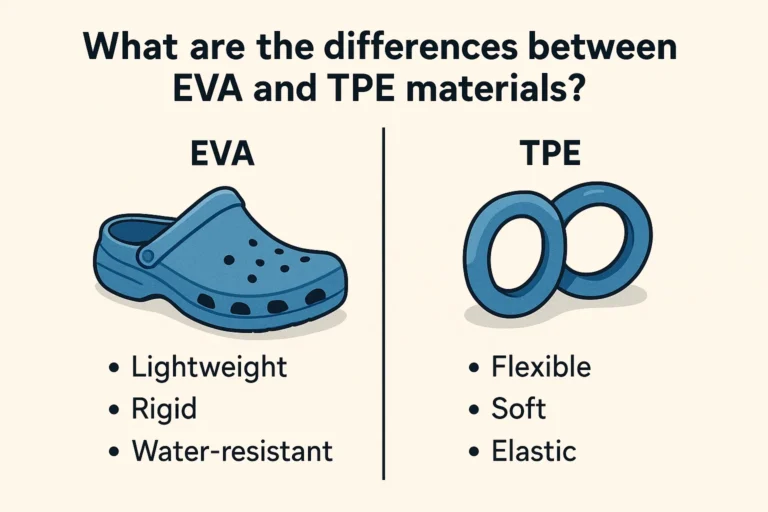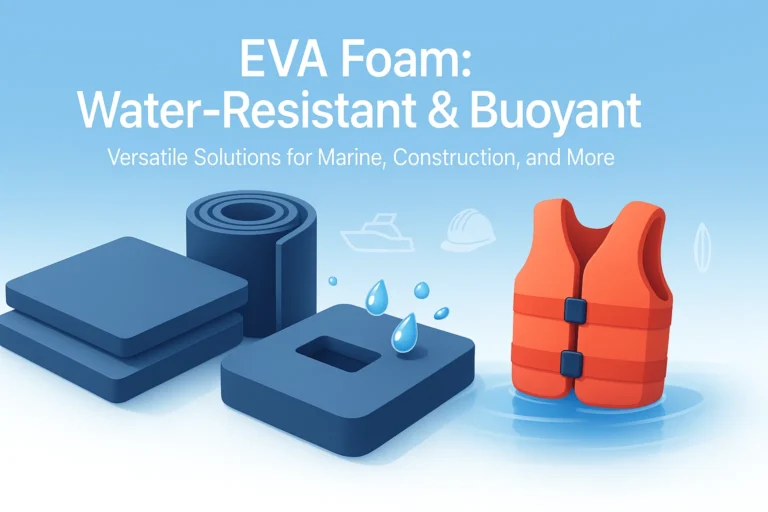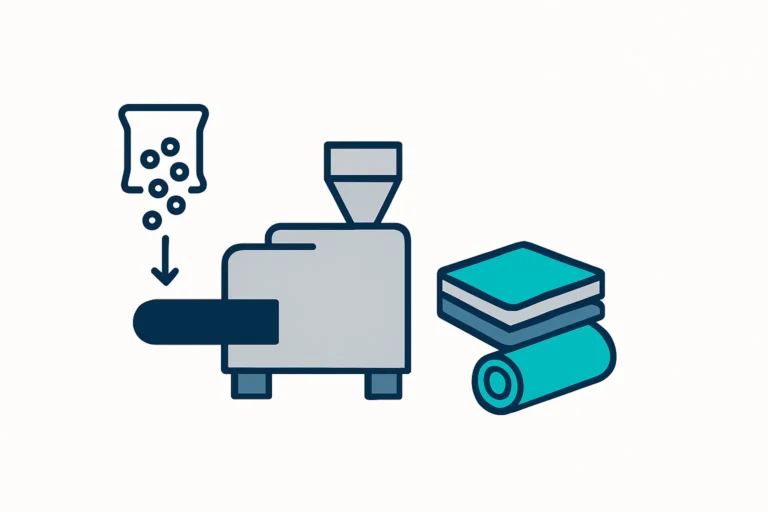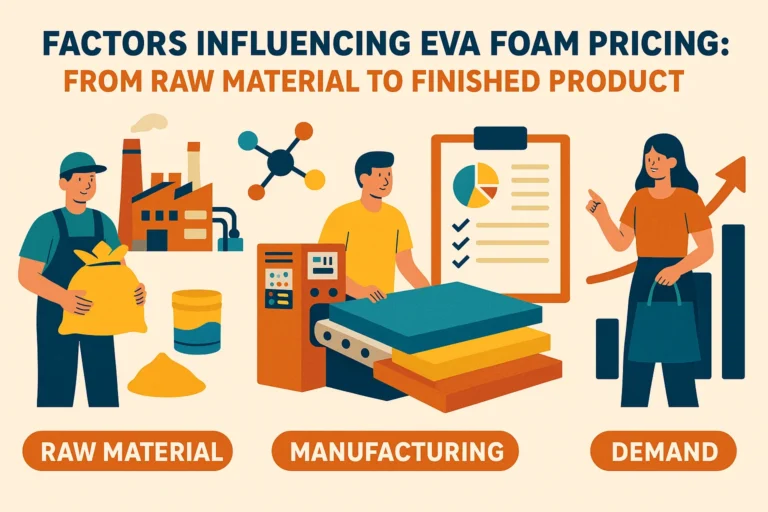Ontsluit de topprestaties van EVA-schuim: De rol van dicylperoxide (DCP)
Welkom bij Damao's deskundige gids over EVA-schuim! Als toonaangevende fabrikant van EVA-schuim vellen, rollen, op maat gemaakte onderdelen en oplossingen voor gespecialiseerde toepassingen, weten we dat de magie achter EVA-schuim van hoge kwaliteit in de chemie zit. Een van de onbezongen helden in dit proces is Dicumyl Peroxide, beter bekend als DCP. Dit cruciale additief speelt een centrale rol bij het transformeren van ruw EVA materiaal in de veelzijdige, duurzame en veerkrachtige schuimproducten waar u op vertrouwt.
Dit artikel gaat in op Dicumyl Peroxide (C18H22O2), de primaire cross-linking agent in veel EVA schuimprocessen. We gaan in op hoe het werkt, waarom het essentieel is en hoe de precieze toepassing ervan leidt tot superieure EVA schuimproducten - van comfortabele schoeiselcomponenten tot beschermende verpakking en alles daartussenin.
Wat is Dicumyl Peroxide (DCP) en waarom is het belangrijk voor EVA-schuim?
Dicumylperoxide (DCP) is een organisch peroxide dat tijdens het productieproces van EVA-schuim een cruciale chemische reactie in gang zet die verknoping wordt genoemd. Zie het als de sleutel die het volledige potentieel van EVA (ethyleenvinylacetaat)-copolymeer ontsluit.
Chemische eigenschappen van DCP:
- Moleculaire formule: C18H22O2
- Kritisch Halfleven: Ontbindt door 90% in slechts 1 minuut bij 160°C (320°F). Deze snelle ontleding bij een specifieke temperatuur is cruciaal voor een gecontroleerde verwerking.
- Effectief decompositiebereik: Gewoonlijk 135-175°C (275-347°F).
Zonder effectieve verknoping zou EVA-materiaal de structurele integriteit, elasticiteit en duurzaamheid missen die het zo populair maken. DCP zorgt ervoor dat de afzonderlijke EVA-moleculaire ketens chemisch aan elkaar worden gekoppeld, waardoor een robuust, driedimensionaal netwerk wordt gevormd. Dit netwerk geeft EVA schuim zijn gewenste eigenschappen.
De wetenschap achter de magie van DCP: hoe het werkt bij EVA-schuimen
De rol van DCP bestaat niet alleen uit het mengen; het gaat om een gecontroleerde chemische reactie die het EVA-materiaal fundamenteel verandert.
- Radicale reacties initiëren: Tijdens de vulkanisatiefase (uitharding) zorgt warmte ervoor dat DCP ontleedt, waarbij zeer reactieve vrije radicalen ontstaan. Deze radicalen zijn de katalysatoren die het verknopingsproces starten.
- Een sterk 3D-netwerk opbouwen: Deze vrije radicalen hebben een wisselwerking met de EVA polymeerketens, waardoor ze aan elkaar worden gekoppeld. Hierdoor ontstaat een sterke, onderling verbonden matrix die het gesmolten EVA verandert van een stroperige vloeistof in een veerkrachtige, elastische vaste stof.
- Synergie met schuimmiddelen: DCP werkt goed samen met andere essentiële ingrediënten. Het kan bijvoorbeeld de ontbinding van schuimmiddelen zoals Azodicarbonamide (AC) beïnvloeden. Deze synergie helpt bij het creëren van een meer uniforme, gesloten celstructuur in het schuim, wat essentieel is voor eigenschappen als demping en isolatie.
- Smeltsterkte verhogen voor betere bubbels: Een belangrijk voordeel van DCP is de verbetering van de smeltsterkte tijdens het schuimproces. Het vernette EVA-materiaal kan de expanderende gasbellen beter bevatten, wat leidt tot een betere integriteit van de bellenwand (studies tonen tot 27% verbetering aan). Dit resulteert in consistentere celgroottes en een stabielere schuimstructuur.
Bij Damao begrijpen we deze mechanismen, waardoor we het schuimproces nauwkeurig kunnen beheersen en ervoor kunnen zorgen dat onze EVA-schuimplaten, -rollen en aangepaste producten aan de hoogste kwaliteitsnormen voldoen.
Uw EVA-schuimproces optimaliseren met DCP: belangrijkste overwegingen
Om het perfecte EVA-schuim te verkrijgen, moet er zorgvuldig aandacht worden besteed aan de verwerkingsparameters, vooral bij het gebruik van DCP.
De juiste dosering (PHR - Parts Per Hundred Resin)
De gebruikte hoeveelheid DCP heeft een directe invloed op de uiteindelijke eigenschappen van het EVA-schuim.
- Standaard uitbreiding (3-5x): Vereist gewoonlijk 0,5-1,2 phr van DCP.
- Hoge uitbreiding (7-10x): Gebruikt vaak een iets lager bereik van 0,3-0,8 phr.
Belangrijke opmerking: De DCP-dosering moet vaak worden aangepast in combinatie met andere activatoren in de formulering, zoals zinkoxide (ZnO) en stearinezuur, om de gewenste reactiekinetiek en schuimeigenschappen te verkrijgen.
Het temperatuurspel onder de knie krijgen: Thermisch protocol
Temperatuurregeling is van het grootste belang om DCP effectief en veilig te laten werken.
| Procesfase | Temperatuurbereik (°C) | DCP Ontleding Status | Waarom het belangrijk is |
| Intern mengen | <120°C | Verwaarloosbaar/Nul | Voorkomt vroegtijdige verknoping (schroeien) |
| Vulkaniseren | 160-170°C | >95% | Zorgt voor volledige en efficiënte cross-linking |
| Na de behandeling | <60°C | Compleet | Zorgt voor veilige hantering en dimensionale stabiliteit |
Belangrijke opmerkingen over compatibiliteit
- Vermijd antioxidanten op aminebasis: DCP is over het algemeen onverenigbaar met antioxidanten op aminebasis, die het radicale verknopingsproces kunnen verstoren.
- Activeringssysteem vereist: Een activeringssysteem, meestal ZnO en Stearinezuur, is meestal nodig om de uithardingsefficiëntie van DCP te optimaliseren.
Belangrijkste prestatievoordelen van het gebruik van DCP in EVA-schuim
Het juiste gebruik van DCP vertaalt zich direct in tastbare verbeteringen in het uiteindelijke EVA schuimproduct. Als uw vertrouwde EVA schuim leverancier, maakt Damao gebruik van deze voordelen om uitmuntendheid te leveren.
- Superieure mechanische sterkte en veerkracht:
- Treksterkte: Verwacht een verbetering van 30-50% in treksterkte, vooral voor schuim met een dichtheid ≤0,25g/cm³. Dit betekent dat het schuim meer trekkracht kan weerstaan voordat het breekt.
- Veerkracht bij rebound: Een verbetering van 15-20% in de veerkracht betekent dat het schuim zijn vorm beter terug krijgt na compressie, wat cruciaal is voor dempingstoepassingen.
- Verbeterde processtabiliteit en -kwaliteit:
- Celuniformiteit: Bereikt een afwijking in celdichtheid van ≤8%, wat leidt tot consistenter schuim.
- Minder defecten: Kan leiden tot een 35-40% vermindering van veelvoorkomende schuimfouten, waardoor de opbrengst en productkwaliteit verbeteren.
- Verbeterde duurzaamheid en levensduur:
- Weerstand tegen compressie-instelling: Een significante verbetering (bijvoorbeeld 2 graden) betekent dat het schuim minder snel blijvend zal vervormen na langdurige compressie.
- Thermische verouderingsbestendigheid: Typisch een vermindering van 25% in eigenschapsverlies na thermische veroudering, waardoor het schuim langer meegaat in veeleisende omstandigheden.
Uw technische vragen over DCP beantwoord
We krijgen vaak technische vragen over DCP. Hier zijn enkele veel voorkomende vragen:
V1: DCP vs. BIPB (Bis(tert-butylperoxy isopropyl)benzeen) - Wanneer kiezen?
Zowel DCP als BIPB zijn uitstekende crosslinkers, maar ze hebben verschillende optimale werkingsvensters:
- DCP: Ideaal voor uithardingsprocessen bij gemiddelde temperaturen, meestal tussen 150-170°C. Het is een veelzijdig werkpaard voor veel standaard EVA schuimtoepassingen.
- BIPB: Beter geschikt voor processen bij lagere temperaturen, rond 130-150°C. Het kan ook de voorkeur genieten als het uiteindelijke schuim een hogere hardheid moet hebben (bv. >65 Shore A), omdat het soms schuim oplevert met minder geur in vergelijking met DCP.
De keuze hangt af van je specifieke verwerkingsapparatuur, gewenste schuimeigenschappen en formulering.
V2: DCP-restanten aanpakken en milieuvriendelijkheid garanderen
De bezorgdheid over restperoxide en zijn bijproducten is terecht. Dit is hoe Damao en verantwoordelijke fabrikanten dit verminderen:
- Voldoende uitharding: Zorg ervoor dat de vulkanisatie plaatsvindt bij >160°C gedurende minstens 90 seconden om de DCP-afbraak te maximaliseren.
- Devolatilisatie: Het implementeren van stappen na het uitharden, zoals tweefasige vacuüm devolatilisatie, kan vluchtige organische stoffen (VOC's) aanzienlijk verminderen.
- Naleving van het doel: Streef ernaar dat de TVOC-niveaus (Total Volatile Organic Compounds) van het eindproduct zo laag mogelijk zijn, idealiter ≤50μg/m³ of voldoen aan specifieke industrienormen.
V3: Problemen met overcrosslinking opsporen en oplossen
Te veel cross-linking (over-uitharding) kan schadelijk zijn. Hier zijn tekenen:
- Oppervlakteverschijning: Radiale scheuren of een "sterpatroon" op het schuimoppervlak kunnen duiden op overharding.
- Verminderde terugslag: Als de compressie-reboundverhouding onder 85% van het optimale doel komt, is er mogelijk sprake van overcrosslinking. Het schuim voelt eerder "dood" dan "verend" aan.
- DSC-analyse: Differentiaalscanning calorimetrie (DSC) zou een resterende kristalliniteit groter dan 25% kunnen laten zien, wat suggereert dat de verknoping de moleculaire beweging te veel heeft beperkt, wat een optimale schuimvorming in de weg staat.
Corrigerende maatregelen zijn het verlagen van de DCP-dosering, het aanpassen van de uithardingstijd/temperatuur of het opnieuw evalueren van het activatorsysteem.
DCP in actie: EVA-schuimtoepassingen van Damao in de praktijk
De veelzijdigheid van DCP-crosslinked EVA-schuim betekent dat het in talloze producten wordt gebruikt. Bij Damao leveren we EVA-schuim vellen, rollen en aangepaste oplossingen voor diverse industrieën:
| Toepassingsgebied | Typische DCP-belading (phr) | Uithardingstemperatuur (°C) | Damao productvoorbeelden |
| Schoeisel tussenzolen | 0.6-0.8 | 160±5 | Lichtgewicht, schokabsorberende sportschoenonderdelen |
| Yoga- en fitnessmatten | 0.4-0.5 | 155±3 | Comfortabele, duurzame 5 mm+ composietmatten, oefenblokken |
| Beschermende verpakking | 1.0-1.2 | 165±5 | Op maat gemaakte EPE-vervangende dempende inzetstukken, kofferbekleding |
| Sportvloeren | 0.8-1.0 | 162±3 | In elkaar grijpende kinderspeelmatten, vechtsportvloeren |
| Pakkingen en afdichtingen op maat | Varieert (0,5-1,0) | Varieert (155-165) | Gestanste EVA schuimpakkingen voor specifieke afdichtingstoepassingen |
| Trimhulpmiddelen | 0.5-0.7 | 160±5 | EVA-schuim met gesloten cellen voor reddingsvesten en drijfmiddelen |
(Opmerking: phr = delen per honderd hars. Waarden zijn indicatief en kunnen variëren op basis van specifieke formuleringen en gewenste eigenschappen).
Partner met Damao voor uw EVA schuim behoeften
Het begrijpen van de wetenschap van additieven zoals Dicumyl Peroxide is slechts één aspect van het produceren van EVA schuim van hoge kwaliteit. Bij Damao combineren we deze technische expertise met ultramoderne productieprocessen om EVA-schuimvellen, -rollen en op maat gemaakte producten te leveren die aan uw exacte specificaties voldoen.
Of u nu materialen nodig hebt voor sportuitrusting, beschermende oplossingen, educatief speelgoed of een andere innovatieve toepassing, ons team staat klaar om u te helpen. Wij zetten ons in om niet alleen superieure producten te leveren, maar ook de technische ondersteuning om u te helpen het meeste uit onze EVA-schuimoplossingen te halen.
Wilt u ontdekken hoe Damao's hoogwaardige EVA-schuim uw producten kan verbeteren? Neem vandaag nog contact met ons op om uw wensen te bespreken of een monster aan te vragen!







